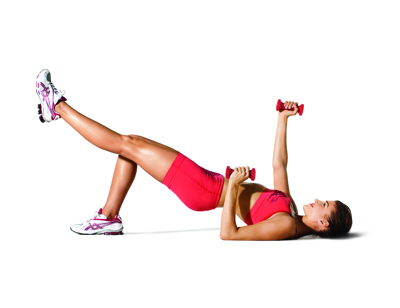By Natalie Gingrich Mackenzie, SELF
Consider this your get-fit trifecta. All you need to tighten and tone is a smart combo of these three fitness fundamentals.
BLOCK 1: CARDIO
Pretty much any activity that gets your blood pumping is cardiovascular. When your heart rate rises, muscle cells break down sugar and fat for fuel, burning calories. Clearly there are a ton of ways to do this, but exercise physiologists lump cardio into three buckets -- long, slow distance (LSD), medium hard (tempo) and high-intensity interval training (HIIT). What's what:
LSD No surprise, these sessions are long (45 to 60 minutes) and slow -- you're creeping at a pace that you can easily sustain. The whole point is to increase your endurance, so you can build a solid foundation to prep for shorter, tougher sessions, says Michele Olson, Ph.D., a professor of exercise physiology at Auburn University in Montgomery, Alabama.
Tempo In these more challenging 20- to 30-minute workouts, you'll close in on your anaerobic threshold, the sweet spot where your body shifts from burning a higher percentage of fat to more carbs, which are easier to access for energy, explains Cedric Bryant, Ph.D., chief science officer at the American Council on Exercise. The upshot: Calorie-burn spikes.
HIIT Kill it, recover, repeat, repeat. On/off bouts like this, lasting 10 to 20 minutes, activate fast-twitch muscle fibers, making you stronger, and create a huge metabolic demand on your body, incinerating calories.
So How Much Cardio Do I Need To Do?
150 Minutes
That's the bare minimum for general health, so bump it to 250 because we know you also want to look good in jeans. Mix up your LSD, tempo and HIIT. High intensity counts double (10 minutes equals 20 toward your weekly total), but do no more than two HIIT sessions a week.
See more: Drop Two Pounds in One Week!
BLOCK 2: STRENGTH TRAINING
The fitness 101 definition: a muscle contracting to resist a force. Pick up a dumbbell, hop on a leg-press machine, squat and you're doing it. After a couple of reps, muscle begins to break down; your body Band-Aids and strengthens that tissue, creating definition and making subsequent sets feel less taxing, explains Brad Schoenfeld, Ph.D., a lecturer in exercise science at Lehman College. And this repair process requires energy (read: burns calories, boosts your metabolism) even when you're at rest, which is why lifting is the secret sauce in body transformation.
OK, you're sold, but what does a solid routine look like? Exercise physiologist Wayne Westcott, Ph.D., maps it out, saying an effective total-body workout should incorporate these functional movements:
Squat Include one, or a fancy variation. Bending and lifting recruits the glutes and thighs -- big muscles, which burn big cals.
Lunge Another lower-bod pleaser. Switch them up -- forward, reverse, side, curtsy -- to sculpt and firm from every angle.
Push Sexy shoulders, a perky chest -- they're impossible without exerting force forward (the up part of a push-up), overhead (think shoulder press) and laterally (rising into side plank).
Pull For every push, add a pull to create balance. A few go-to upper-body firmers: rows, chin-ups and rope pulls.
Rotate Twisting your trunk (wood chops, punching) activates abs and obliques ... and doesn't hurt your tennis swing, either.
So How Much Strength Should I Do?
2 or 3 Total-Body Sessions
Some folks have arm day and butt day. They're called bodybuilders. Your mission is to squat, lunge, push, pull and rotate. Choose five to eight exercises, and as long as they include these movement patterns, equipment is purely preference. Do two or three sets of 12 reps on nonconsecutive days. It'll take you about 30 minutes.
See more: The 24-Minute At-Home Boot Camp
BLOCK 3: FLEXIBILITY
High-five if you can touch your toes or do a split, but that's not what we're talking about here. This block is your TLC, a big thank-you to your body for putting up with all of that hard cardio and strength work. Two options:
Stretching Maybe in your mind it's torturous. Stretch anyway. Remember: You're saying thank you. Now, a few pointers: Try to target muscles in pairs. Paying equal attention to opposing muscles keeps your body balanced. Example: Stretch your hammies, then quads, so hips and knees stay aligned. You want to hold that (or any) stretch for 10 to 30 seconds. It takes at least 10 seconds for muscle fibers to relax (that is the end goal) and lengthen. Finally, make sure you focus on all of your muscles -- not just the screamers -- for total flexibility.
Myofascial Release Just a fancy word for massage, and it's easiest to do with a foam roller. Using a roller for 10 minutes after a workout reduces inflammation and triggers the production of new mitochondria, the power plants of your cells, a McMaster University study reports. Do small, back-and-forth movements over tender areas for 30 to 60 seconds to smooth knots and realign elastic muscle fibers.
So How Much Flexibility Should I Do?
2 Mini-Sessions
Squeeze in 10 minutes of allover foam rolling and/or stretching post- or pre-workout, during commercial breaks, anytime, to fulfill your TLC.
More from SELF:
20 Superfoods For Weight Loss
Secrets To Firing Up Your Metabolism
6 Moves To Resize Your Butt and Thighs
Look Better Naked
photos: Jorg Badura

